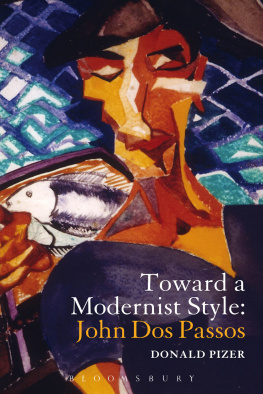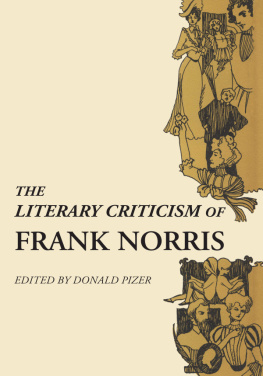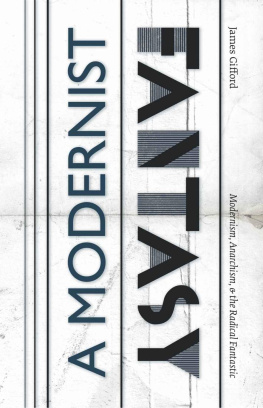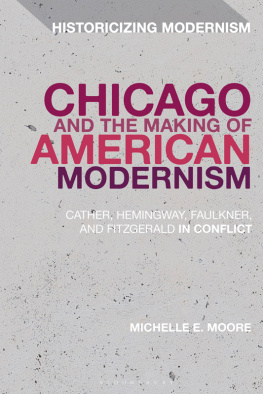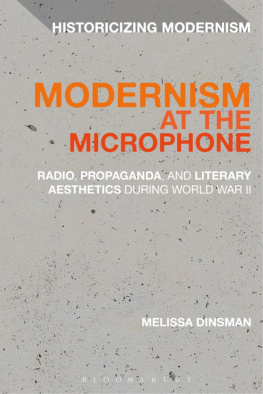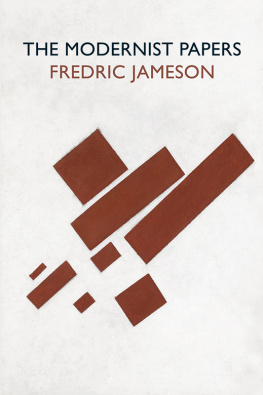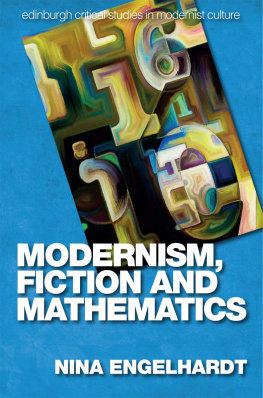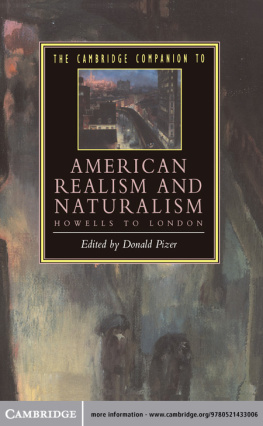Toward a Modernist Style: John Dos Passos
Toward a Modernist Style: John Dos Passos
A Collection of Essays
By
Donald Pizer

Contents
The only words against POWER SUPERPOWER Passage in John Dos Passos The Big Money
| Pages 5245 of the first printing of The Big Money (New York: Harcourt, Brace, 1936) 85 |
| Page of a draft of Camera Eye (51), The Big Money (John Dos Passos Collection, Alderman Library, University of Virginia, Accession 5950, Box 5) 87 |
| Page 618 of the setting copy of The Big Money (John Dos Passos Collection, Alderman Library, University of Virginia, Accession 5950, Box 5) 88 |
The Paintings of John Dos Passos
The figures below can be found in the colour plate section of this volume.
| [Arab Group, 1922.] Watercolor. Collection of Lucy Dos Passos Coggin |
| [Work Boat, 192324.] Watercolor. Collection of Lucy Dos Passos Coggin |
| Dust Jacket, The Garbage Man, 1926. Watercolor. Courtesy of Richard Layman |
| [Urban Center, 192627.] Watercolor. Collection of Lucy Dos Passos Coggin |
| [Nude, mid-1920s.] Watercolor. Collection of Lucy Dos Passos Coggin |
| [Nude Sketch, mid-1920s.] Charcoal. Collection of Lucy Dos Passos Coggin |
| [The Moon is a Gong 1,] 1925. Gouache. Collection of Lucy Dos Passos Coggin |
| [The Moon is a Gong 2,] 1925. Watercolor. Collection of Lucy Dos Passos Coggin |
| [Fisherman, 1927.] Watercolor. Collection of Lucy Dos Passos Coggin |
| [Circus, mid or late 1920s.] Watercolor. Collection of Lucy Dos Passos Coggin |
My interest in John Dos Passoss work and career stemmed from and followed the same course as my earlier writing on Theodore Dreiser during the late 1960s and much of the 1970s. Although the two figures were separated by a generation (Dreiser was born in 1870, Dos Passos in 1896), by the 1930s they were often cited as two of the principal exponents of American literary naturalisma designation that is still maintained. Dreiser of course expressed his themes within the traditional nineteenth-century form of the novel as mock biography, while Dos Passos deployed a number of modernistic experimental fictional techniques. But both writers in their most well-known works responded to the naturalistic impulse to represent in full detail the various ways in which the average American was circumscribed in his activities and beliefs by the circumstances of his life.
My initial research on Dos Passos, beginning in the late 1970s, dealt with U.S.A. , since it provided the best example of his unique combination of naturalistic themes, and experimental fictional devices. This effort produced a chapter on U.S.A. in my 1982 study Twentieth-Century American Literary Naturalism: An Interpretation as well as an essay on the nature of the trilogys Camera Eye device. It also stimulated me to undertake research on the full range of Dos Passoss work and career. I began by spending a summer at the University of Virginia Library examining its extensive Dos Passos collection. My intent was to gather material for a book about all his fiction, just as my research at the University of Pennsylvanias Dreiser Collection had led to my The Novels of Theodore Dreiser (1976). I soon realized, however, that given both the extent of the collection, and the uneven nature of Dos Passoss fiction over a long career, it was necessary for me to narrow my sights. Again U.S.A. provided the obvious means of doing so. Since it was at once his most experimental work and an acknowledged twentieth-century masterpiece, it therefore both required, and profited from having an entire book devoted to it. It was not until 1986, however, that I was able to find the time to write the book, which appeared in 1988 as Dos Passos U.S.A.: A Critical Study.
By the mid-1980s, I was devoting more and more of my research and writing to various phases of American expression of the first half of the twentieth century. One of these phases was the vibrant 1920s expatriate movement; another was fictional modernism. Dos Passos played a striking role in both of these, and I was able to draw upon my knowledge of this participation for a number of essays over the following decades. The final two essays of this collection deal with important but either frequently misunderstood or neglected areas of Dos Passoss careerhis relationship with Ernest Hemingway and his lifelong commitment to painting.
It is no accident that all my writing on Dos Passos has centered on his work of the 1920sthis despite the fact that he continued to publish prolifically until his death in 1970. Dos Passos was one of those fortunate artists whose background, temperament, and temper of the times were in productive relationship with each other during a specific era and thus coalesced into a powerful expressive tool. Rebelling against his upper-middle class upbringing and the reigning aestheticism of his Harvard years, he found himself, after a transforming participation in the War, in the midst of a decade in which other intellectuals and artists of all persuasions were also in revolt and were thus creating a milieu of ideas and artistic styles expressive of that frame of mind. If most Americans applauded Americas emergence as an industrial giant and its decisive role in the War to Save Democracy, Dos Passos and many of his generations artists and writers rejected these and similar positions. And if he and these other rebels found it impossible to live in a country which espoused a mechanical civilization and which also supported an art of platitudes expressed by means of outworn forms, they could find a freer and more congenial artistic climate abroad. Dos Passoss life and work of the 1920s, from Three Soldiers to the climactic achievement of U.S.A. , is thus a paradigm of the archetypal American artist of the decade. Rejecting his own class and its values, he was energized by this act of revolt to create out of the ferment of literary modernism a body of work that is both fully expressive of its moment and has stood the test of time. The essays that follow thus have a number of recurrent interwoven themes. They seek to chart the evolution of Dos Passoss artistic sensibility from its largely conventional expression at the start of the decade to the radical formal experimentation of U.S.A. at its close. They also seek to place this development in the context of contemporary ideas about art and society that served as the matrix for this development. And, finally, they seek to describe the centers of artistic strength in his best work.
During the 1920s and 1930s, Dos Passos was frequently considered one of the most important writers of his generation. On the completion of U.S.A. in 1936, he appeared on the cover of Time magazine, and in 1938 Jean-Paul Sartre named him the greatest writer of our time. But for several reasons his reputation declined over the remainder of his lengthy career and continued to do so for some decades afterwards. An initial cause of this decline was his increasing disenchantment, brought to a head by the Spanish Civil War, with leftist ideas, and activities and his concomitant outspoken support of right-wing positions from the late 1940s to his death. In addition, it was commonly held that his later novels lacked the freshness and edge of his earlier workthat they were largely tired reprises of older devices and strategies. These beliefs about his later career should not have affected estimates of his earlier work, but they did. In a period during which critical standards of value derived principally from the novels of Henry James and William Faulknerthat is, that significant fiction contained either psychological depth or a tragic visionDos Passoss work as a whole was felt to be deficient in both.
Next page
